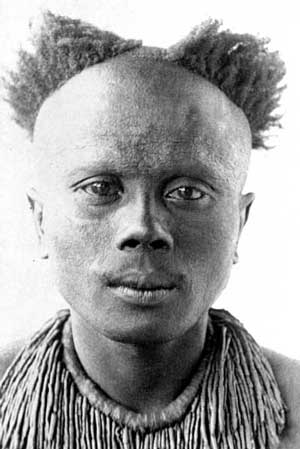
The Andamanese languages are the various languages spoken by the indigenous peoples of the Andaman Islands in the Indian Ocean. There are two known Andamanese language families, Great Andamanese and Ongan, as well as two presumed but unattested languages, Sentinelese and Jangil.

The Pucikwar language, A-Pucikwar, is an extinct language of the Andaman Islands, India, formerly spoken by the Pucikwar people on the south coast of Middle Andaman, the northeast coast of South Andaman, and on Baratang Island. It belonged to the Great Andamanese family.
The Pucikwar were one of the indigenous peoples of the Andaman Islands, one of the ten or so Great Andamanese tribes identified by British colonials in the 1860s. They spoke a distinctive Pucikwar language (A-Pucikwar) closely related to the other Great Andamanese languages. The tribe disappeared as a distinct group sometime after 1931.

The Great Andamanese are an indigenous people of the Great Andaman archipelago in the Andaman Islands. Historically, the Great Andamanese lived throughout the archipelago, and were divided into ten major tribes. Their distinct but closely related languages comprised the Great Andamanese languages, one of the two identified Andamanese language families.
The Jangil were one of the Indigenous peoples of the Andaman Islands in India. They lived in the interior of Rutland Island, and were given the name Rutland Jarawa because it was supposed that they were related to the neighboring Jarawa people.

The Bea language, Aka-Bea, is an extinct Great Andamanese language of the Southern group. It was spoken around the western Andaman Strait and around the northern and western coast of South Andaman.

The Bale language, Akar-Bale, is an extinct Southern Great Andamanese language once spoken in the Andaman Islands in Ritchie's Archipelago, Havelock Island, and Neill Island.

Ongan, also called Angan, South Andamanese or Jarawa–Onge, is a phylum which comprises two attested Andamanese languages spoken in the southern Andaman Islands.

The Great Andamanese languages are a nearly extinct language family once spoken by the Great Andamanese peoples of the northern and central Andaman Islands in the Indian Ocean, and part of the Andamanese sprachbund.

The Kede language, Aka-Kede, is an extinct Great Andamanese language, of the Northern group. It was spoken in the Northern section of Middle Andaman island.

The Kol language, Aka-Kol, is an extinct Great Andamanese language, of the Central group. It was spoken in the southeast section of Middle Andaman.

The Juwoi language, Oko-Juwoi, is an extinct Great Andamanese language, of the Central group. It was spoken in the west central and southwest interior of Middle Andaman.

The Bo language, Aka-Bo, was a Great Andamanese language. It was spoken on the west central coast of North Andaman and on North Reef Island of the Andaman Islands in India. It was recorded as being mutually intelligible with Aka-Jeru, and the vocabularies are very similar.

The Jeru language, Aka-Jeru, is a moribund Great Andamanese language, of the Northern group. Jeru was spoken in the interior and south coast of North Andaman and on Sound Island. A koiné of Aka-Jeru and other northern Great Andamanese languages was once spoken on Strait Island; the last semi-fluent speaker of this, Nao Jr., died in 2009. Aka-Jeru is the last surviving member of the Great Andamanese languages. According to a grammar on Aka-Jeru, it and Aka-Cari are dialects of a singular language, with lexical correspondency between the two at 93%.

The Kora (Cora) language, Aka-Kora, is an extinct Great Andamanese language, of the Northern group. It was spoken on the northeast and north central coasts of North Andaman and on Smith Island.

Järawa or Jarwa is one of the Ongan languages. It is spoken by the Jarawa people inhabiting the interior and south central Rutland Island, central interior, and south interior South Andaman Island, and the west coast of Middle Andaman Island.

Boa Sr was an Indian Great Andamanese elder. She was the last person fluent in the Aka-Bo language.

The Bo was one of the ten Indigenous tribes of the Great Andamanese people, originally living on the western coast of North Andaman Island in the Indian Ocean.

The Kora, Khora or Cora were one of the ten Indigenous tribes of the Great Andamanese people, originally living on the eastern part of North Andaman Island in the Indian Ocean. The tribe is now extinct, although some of the remaining Great Andamanese on Strait Island claim to have Kora ancestors.

The Kari, Cari, or Chariar were one of the ten indigenous Great Andamanese peoples, originally living on the northernmost part of North Andaman Island and on Landfall Island in the Indian Ocean.




